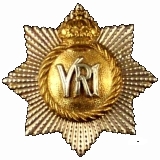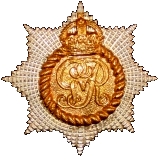
The First World War
War Diary of The Royal Canadian Regiment
Transcription by Captain Michael O'Leary, The RCR.
SEPTEMBER 1918
NARRATIVE OF OPERATIONS, 28th., 29th., 30th., September, 1918.
Part I.
On the 26th September 1918, the Regiment moved from DAINVILLE Area by meter-bus to BULLECOURT; then marched to assembly area through QUEANT arriving there 5.20 morning of 27th September. At 8.30 a.m. they moved to E.5.d. with a strength of 23 Officers and 588 other ranks. At 6.00 p.m. they again moved to F.1.b. remaining until 3.00 a.m. 28th September, when they moved to BOURLON WOOD. "D", "C" and "A" Companies being in the front line, "B" Company in reserve.
At 5.30 a.m. they jumped off. Little opposition was met with during preliminary stages, the prisoners taken numbered about 50. One long field gun and one light field gun being captured. Opposition was met and heavy Machine Gun fire at F.4.d. on the right, and F.4.a. The right company was temporarily checked, but an opening being located in enemy wire, a footing was gained in MARCOING LINE. On the left the enemy still occupied houses along the CAMBRAI Road and RAILLENCOURT and sever fighting took place. Three anti-tank guns were encountered and put out of action on the CAMBRAI ROAD between RAILLENCOURT and part of SAILLY with the intention of coming behind the village of ST. OLLE, but were infeladed [sic] by Machine Gun Fire from high ground on the extreme right of the Brigade Frontage and houses in ST. OLLE.
The remaining two platoons of the Reserve Company were instructed and worked up the CAMBRAI ROAD from house to house towards ST. OLLE. Word was then received from Reserve Company that the right company that was clearing the MARCOING Trench, was being forced back owing to lack of grenades, and that the enemy were attempting to come from the MARCOING SUPPORT LINE to the MARCOING LINE. A platoon of the Reserve Company, picking stragglers from "A" and "C" Companies, was sent to MARCOING LINE to reinforce the right company. MARCOING LINE was then cleared of the enemy as far as F.5.c.7.0. This was at 12.30 p.m.
Touch with the left flank was established, the right flank being in the air.
Battalion Headquarters was established at F.4.d.40.30; R.A.P. at X.28.e.70.00.
The MARCOING SUPPORT LINE was also occupied, at 8.30 p.m. by two companies, the other two remaining in MARCOING LINE.
Part II.
On the night of 29th September, the battalion reorganized as three companies. They assembled at S.19.Central at 5.30 a.m. September 30th.
After jumping off, intense Machine Gun Fire was encountered from both flanks, especially from the left, as well as frontal from S.16.Central.
Left company reached the Chapel in S.15.b. Considerable casualties were caused. The position eventually became untenable and the 4TH Division were falling back on the left flank. Finally position was established in the sunken road running through S.20.b.
At noon, information was received that BLECOURT and TILLOY WOOD were occupied by our troops and we again jumped off, but as this information proved to be incorrect, Machine Guns opened fire from these places and stopped our advance. One Officer and 40 other ranks remained dug-in at S.21.a. Another attempt was again made at 4.00 p.m. on information received that the enemy were retiring from TILLOY WOOD, and that SANCOURT was occupied by our troops; this was also incorrect as the advance was checked by cross-fire from both Flanks. At 6.00 p.m. the Battalion was holding positions as follows: In sunken road in S.20.b. and S.21.a. This line was held until the 9TH Brigade passed through at 5.00 a.m. 1st October.
REMARKS.
Not enough liaison between Infantry and Artillery, as was emphasized when advance was checked by Machine Guns in houses in ST. OLLE, on the 28th September and Artillery could not be notified of it.
On the 28th September, the tanks worked too far to the right, one tank which went to the right was put out of action by Machine Gun Fire. Remaining three on the left were put out of action by Machine Gun Fire and one Gun of fairly heavy calibre with open sights.
Bombs figured greatly in clearing the MARCOING LINE.
Estimated Machine Guns captured amounted to 54. Prisoners seen returning 130, captured guns and anti-tank guns 5. Casualties inflicted on the enemy were approximately 700.
LESSONS LEARNED.
1. No matter how far the advance, a Battalion Headquarters should be permanently established (series of report centres mapped out) and if it is to be moved someone should be left to re-direct messages to new Battalion Headquarters.
2. That a two company frontage on the same proportion as a Battalion frontage could be as effective, and save casualties if greater interval was maintained.
3. That the support (P.P.C.L.I.) Bn. were too close behind us (R.C.R.) and in one instance got between our Reserve Company and front Companies.
4. Whippets would have proved effective in the fighting where the Mark IV or V were useless.
3-10-1918.
(signed)
C.L. Wood
Captain.
Commanding The Royal Canadian Regiment.
- The O'Leary Collection; Medals of The Royal Canadian Regiment.
- Researching Canadian Soldiers of the First World War
- Researching The Royal Canadian Regiment
- The RCR in the First World War
- Badges of The RCR
- The Senior Subaltern
- The Minute Book (blog)
- Rogue Papers
- Tactical Primers
- The Regimental Library
- Battle Honours
- Perpetuation of the CEF
- A Miscellany
- Quotes
- The Frontenac Times
- Site Map

![]() The RCR in the Great War
The RCR in the Great War
![]() War Diary
War Diary
![]() Battle Honours
Battle Honours
![]() Battle Bars and The RCR
Battle Bars and The RCR
![]() The RCR Battle Bar Ledger (pdf)
The RCR Battle Bar Ledger (pdf)
![]() Honours and Awards
Honours and Awards
![]() Roll of Honour
Roll of Honour
![]() Prisoners of War
Prisoners of War
![]() Cemetery List
Cemetery List
![]() Cemetery Map
Cemetery Map
![]() Courts Martial
Courts Martial
![]() Officers
Officers
![]() RSMs of The RCR (1914-1919)
RSMs of The RCR (1914-1919)
![]() NCOs and Soldiers
NCOs and Soldiers
![]() An Officer's Diary (1914-1918)
An Officer's Diary (1914-1918)
![]() Recollections of a Nonagenerian (R. England) (1916-1919)
Recollections of a Nonagenerian (R. England) (1916-1919)
![]() On to Bermuda (1914-15)
On to Bermuda (1914-15)
![]() England and France 1915-1916 (Hayes; 1931)
England and France 1915-1916 (Hayes; 1931)
![]() Overseas with The Royals (1915)
Overseas with The Royals (1915)
![]() Regimental History Pamphlet (1917)
Regimental History Pamphlet (1917)
![]() Amiens (1918)
Amiens (1918)
![]() Cambrai (1918)
Cambrai (1918)
![]() Monchy-le-Preux (1918)
Monchy-le-Preux (1918)
![]() Under-aged Soldiers in The RCR
Under-aged Soldiers in The RCR
![]() Not All Were Volunteers; The RCR and the Military Service Act
Not All Were Volunteers; The RCR and the Military Service Act
![]() Sentenced to Death by Court Martial
Sentenced to Death by Court Martial
![]() The 7th Trench Mortar Battery
The 7th Trench Mortar Battery
![]() A Regimental Goat
A Regimental Goat
![]() Regiment and Family, Bermuda 1914-15
Regiment and Family, Bermuda 1914-15
![]() "March the Guilty Bastard In"
"March the Guilty Bastard In"
![]() Surrendered as Stowaway
Surrendered as Stowaway
![]() Re-Visiting the Great War Roll of Honour for The RCR
Re-Visiting the Great War Roll of Honour for The RCR
![]() Canadian Corps Trench Standing Orders (1916)
Canadian Corps Trench Standing Orders (1916)

